Austin Facility Shows Potential of Greener Self Storage
A LEED Platinum-certified property demonstrates the potential of self storage facilities to achieve high performance in power and water conservation.

CubeSmart’s LEED Platinum-certified self storage facility in Austin. Image courtesy of U.S. Green Building Council
Self storage facilities are proliferating across the U.S. Estimates place the number of self storage facilities dotting the nation above 47,000 at the end of 2019, a year-over-year increase of more than 2,300 locations. The sheer volume of self storage assets invites the question: What if all or most of those facilities were rendered more energy efficient?
READ ALSO: Self Storage and Investing in Opportunity Zones During COVID-19
A self storage facility in Southeast Austin is designed to help answer that question. Located on East Ben White Boulevard west of Austin-Bergstrom International Airport, the CubeSmart-owned property earned more points under the LEED operations and maintenance rating system for warehouses and distribution centers than any other property in Texas.
Growing larger
Self storage facilities offer ample opportunity for sustainable, energy efficient operations. “In Austin I can travel 3 miles and see three new facilities. It’s a phenomenally robust industry, said Gail Vittori, co-director of the Center for Maximum Potential Building Systems, which participated in creating the project. Established in 1975, the nonprofit explores opportunities to achieve sustainability through protocols, prototypes and policy. Making the nation’s self storage inventory greener would “achieve a very high level of health, environmental and social benefit across all the facilities,” Vittori adds.
By the nature of self storage, “these spaces have a personal relationship with people, and therefore a unique chance to communicate how to make more sustainable decisions and the impact it can have,” noted Kat Wagenschutz, Wayne, Pa.-based director of technical solutions at the U.S. Green Building Council.
At its 2016 opening, the facility earned a four-star rating from Austin Energy, a city-owned utility. As a participant in Austin Energy’s GreenChoice program, the facility will source additional energy entirely from wind power generated in Texas. The architect, Bob Ruggles of Lake Forest, Ill.-based Ruggles Architecture pursued LEED certification for the project, which he achieved in December 2018.
The 78,700-square-foot facility’s net zero energy capability results from conservation features like solar PV arrays, rainwater towers, geothermal heating and cooling, and a regenerative-drive elevator generating electricity from the elevator’s movement. Thirteen geothermal heat pumps provide 40 tons of capacity.
Feasible pursuit
One of the facility’s three 7,000-gallon cisterns provides all water needed for irrigation of the property’s native and adapted plant landscape. One-third of the site, or 30,123 square feet, is preserved as open space, serving as a conservation easement. It is planted with native ground cover and grass species providing habitat for local fauna.
A video monitor tracks energy performance. It indicates electricity generated, electricity used, carbon dioxide offsets and money conserved by depending on the onsite solar-generated rather than grid-connected electricity.
As the Austin facility showed, properties needn’t be new to make green gains, Vittori said. Operational changes including transitioning to integrated pest management, green housekeeping, use of healthier cleaning products and recyclable office supplies, and switching from incandescent to energy-conserving LED light bulbs all represent steps that can be introduced at existing self storage buildings, she said.
Existing buildings can transition to earn LEED certification, Wagenschutz added. Arc, a platform measuring building sustainability performance, allows owners of any building to start tracking its performance at no cost. “Arc is integrated into LEED, so as spaces continue to improve performance, submitting for certification becomes a seamless process,” she said. “It sets teams up for ongoing performance tracking for that building, and across entire portfolios.”
Even relatively small gains across such a huge and expanding built environment can exert a big impact, Vittori reiterated. “Someone has to say, ‘Let’s explore how to improve by 10 or 15 percent or more in water and electricity conservation at these facilities,” she said.”It’s an industry that’s very much self-repeating. You do the same things again and again and again. Let’s pause and look at the next generation of self storage, exploring these higher-performing opportunities.”







You must be logged in to post a comment.